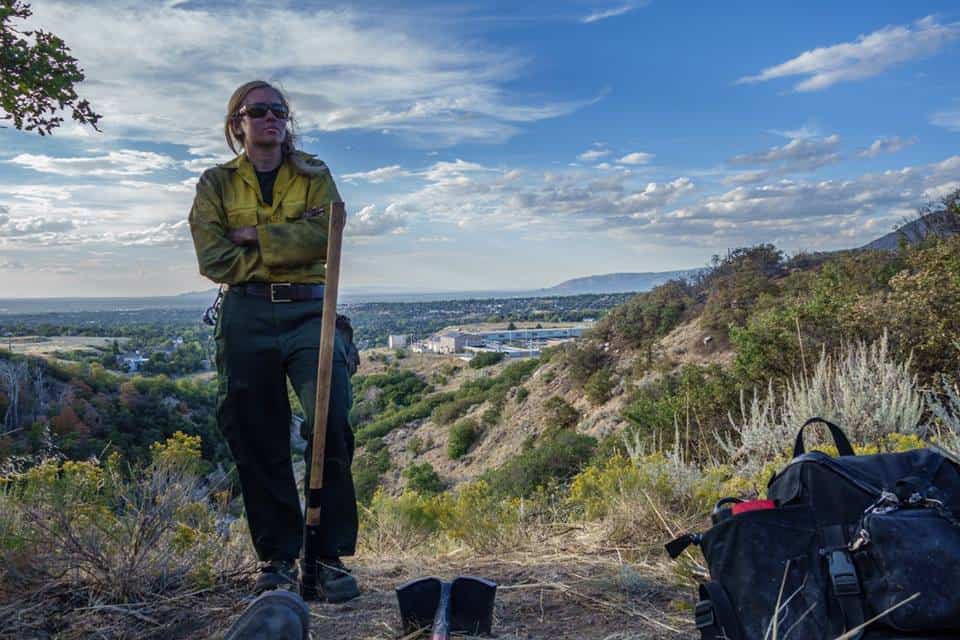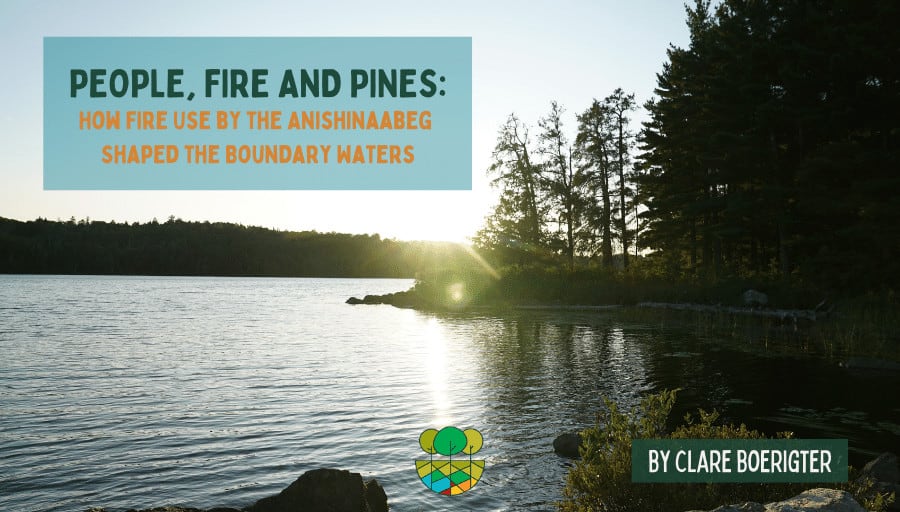Editor’s note: Clare Boerigter is an environmental storyteller and science communicator based in Minneapolis, Minnesota. Through essays, storymaps and articles, Clare explores the complex story of fire on our landscapes. In “People, Fire and Pines: How Fire Use by the Anishinaabeg Shaped the Boundary Waters,” a storymap Clare completed in August 2022, she reexamines Western ideas about wilderness – and the role of people in shaping one of Minnesota’s most beloved natural spaces. For more writing by Clare, visit clareboerigter.com.
Fire first came into my life in 2011: I was nineteen, a college student interning with an archaeologist in a national forest in Arizona. Growing up in the midwest, I was clueless about wildfires. But spending time that summer with the forests’ fire prevention officer, I began to understand the ways in which fire had shaped – and was still shaping – the American West.

Clare Boerigter on a 2015 fire within the city limits of Salt Lake City, Utah
The next summer, I joined a 10–person wildland fire module based out of Utah. In less than five months, I worked nearly a thousand hours of overtime on 15 fires in Utah, Idaho and Wyoming, including 4 fires in federal wildernesses. As a wildland fire module, my crew worked on typical suppression fires, but our real specialty was managing wildfires deep in the wilderness. We understood that fire was an important ecological disturbance for many ecosystems, capable of provoking abundance and renewal. In wilderness areas, allowing wildfires to burn – reducing fuel loads by consuming dead, downed and diseased trees while making way for new growth – was often the smartest policy.
With the skills to create detailed GIS maps, protect historical structures and other resources, and monitor key trigger points, my crew was able to facilitate these wilderness fires. Two more seasons as a wildland firefighter followed for me before I put my White’s boots away for good in 2015.
But I wasn’t done with fire. Back in the midwest in 2019, I began working as an environmental storyteller for the University of Minnesota’s Cloquet Forestry Center, a 3400-acre experimental forest located on the Fond du Lac Band of Lake Superior Chippewa Reservation. Suddenly, I was seeing a whole new side of fire: from Ojibwe firefighters and elders, I learned about cultural fire and the incredible influence of Indigenous peoples’ use of fire on landscapes across America and around the world. Good fire didn’t just keep our ecosystems healthy – for many Indigenous peoples, it was also the mark of a thriving relationship between people and land.

An Anishinaabe family canoeing on Basswood River in the Boundary Waters in 1915 (Superior National Forest Historical Photos)
Last summer, I continued to explore good fire through an article for the Coalition for Archaeological Synthesis. In “People, Fire and Pines: How Fire Use by the Anishinaabeg Shaped the Boundary Waters,” I speak with a range of Ojibwe and non-Ojibwe experts to complicate the false-yet-still dominant narrative of Minnesota’s beloved Boundary Waters Canoe Area as a wilderness “untrammeled by man.” The relationship between the Anishinaabeg – a group of tribes in the Great Lakes region that includes the Ojibwe – and fire is a central part of this story, with their burning practices influencing the forest ecosystems of the Boundary Waters.
As Damon Panek, wildfire operations specialist for the Fond du Lac Band of Lake Superior Chippewa, says in a recent episode of the podcast [Un]Natural Selection, “The Boundary Waters wouldn’t be what it is without [human-lit] fire on the landscape.”
Today, however, the fires historically lit by the Anishinaabeg have been removed from the Boundary Waters, a million acre expanse of forest and chain lakes which is overseen by the U.S. Forest Service. When lightning fires do occur on this landscape, state and federal agencies work hard to suppress them. Ecologically, spiritually and relationally, the absence of fire has been felt across the forests of the Boundary Waters.

Fire in the Boundary Waters (photo by Kari Greer)
Through conversations with a range of people, I investigate the questions: Are there ways to live with fire, instead of suppressing it? In what ways, by attempting to live without fire, have we harmfully impacted both land and people? And what can the Boundary Waters – a wilderness often defined as free of human influence – teach us about the relationships between people and fire?
To explore these questions with me, please read “People, Fire and Pines: How Fire Use by the Anishinaabeg Shaped the Boundary Waters”!
****

